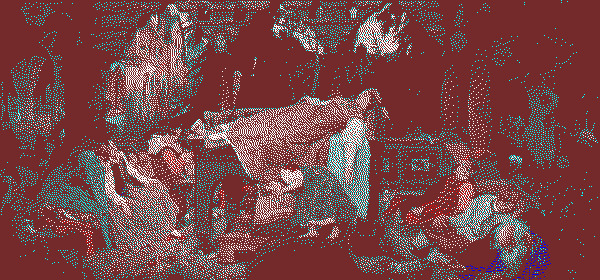Viktor Vasnetsov through Anti-Oedipus
april 5 2025

“The earth is dead, the desert is growing: the old father is dead, the territorial father, and the son too, the despot Oedipus. We are alone with our bad conscience and our boredom, our life where nothing happens; nothing left but images that revolve within the infinite subjective representation.” (308)
Viktor Vasnetsov was a Russian artist. He was born in the Russian Empire in 1848, and he died in the Soviet Union in 1926. Vasnetsov painted folkloric and historical paintings that were embraced both by the Tsar and the Soviet people. Even the Bogatyr-style “Budenovka” hat that he’d designed for the Russian army later became a symbol of the Red Army. His popularity in the early Soviet period came as a surprise to me; the Russian avant-garde at the time was undoubtedly more revolutionary, Kazimir Malevich’s "Black Square" having done much more to offend bourgeois tastes than the church architect and fresco painter. But it could be said that Vasnetsov foreshadowed the later dominance of Socialist Realism.
In their book Anti-Oedipus, Deleuze and Guattari elaborate on their concept of the “Urstaat.” The Urstaat is a model of the despotic state that represents its potential within the past. It originates as a reaction against new distinctions of private property, commodities, and classes that threatened the established social codes, codes that maintained despotic control over the dangerous speed of technological progress. The spread of Christianity in Europe demonstrates this when it maintained the ideals of the Roman Empire despite having enabled its downfall. In art, there are the endless examples of Classicism where pagan imagery does not contradict its Christian theme as much as it elevates it. What’s important is that the despotic state renders the Urstaat immanent to itself; a seemingly different form of social organization becomes an interior potential of the current form.
“Democracy, fascism, or socialism, which of these is not haunted by the Urstaat as a model without equal?” (261)
However, the Urstaat does not end with the despot. While it once functioned as an apparatus of antiproduction — something that transcended the field of production to stall its revolutions — the Urstaat was appropriated by capitalism to render even antiproduction immanent to production. Capitalism appropriates technological progress to serve and reproduce capital, unlike the threat it posed to the despot, and it especially takes advantage of the Urstaat’s power to widen its field of immanence. Deleuze and Guattari write:
“They are torn in two directions: archaism and futurism, neoarchaism and ex-futurism, paranoia and schizophrenia. They vacillate between two poles: the paranoic despotic sign, the sign-signifier of the despot that they try to revive as a unit of code; and the sign-figure of the schizo[phrenic] as a unit of decoded flux, a schiz, a point-sign or flow-break. They try to hold on to the one, but they pour or flow out through the other. They are continually behind or ahead of themselves.” (260)
Capitalist historicity is always where it serves itself, looking to the future until it is too progressive, then looking to the past until it is too conservative. And this is still relevant to the socialist revolution experienced by Viktor Vasnetsov; Deleuze and Guattari argue that the Soviets sabotaged their revolutionary capacities when they appealed to Russian nationalism. The Budenovka-wearing Bolsheviks made a Medieval romance out of the class struggle of the proletariat (what even Marx mocked when the bourgeois economists made romance out of the capitalist’s struggle against feudalism), rendering the Soviet Union vulnerable to the capitalist appropriation of the Urstaat. And after Vasnetsov’s injection of the viral Urstaat, it would appear again to kill off Vladimir Tatlin’s "Monument to the Third International" for the mandate of Socialist Realism.
“Take the example of the Venetian School in painting: at the same time that Venice develops the most powerful commodity capitalism, bordering an Urstaat, that grants it a large degree of autonomy, its painting apparently molds itself to a Byzantine code where even the colors and the lines are subordinated to a signifier that determines their hierarchy as a vertical order. But toward the middle of the fifteenth century, when Venetian capitalism confronts the first signs of its decline, something breaks out in this painting: what would appear to be another world opens up, an other art, where the lines are deterritorialized, the colors are decoded, and now only refer to the relations they entertain among themselves, and with one another . . . And of course this decoding of the flows of painting, these schizoid lines of escape that form desiring-machines on the horizon, are taken up again in scraps from the old code, or else introduced into new codes, and first of all into a properly pictorial axiomatic that chokes off the escapes, closes the whole constellation to the transversal relations between lines and colors, and reduces it to archaic or new territorialities (perspective, for example).” (369)
Not to say that Vasnetsov’s art is bad, or that Socialist Realism is bad. There are Vasnetsov works I like and Socialist Realist works I like. But Deleuze and Guattari’s concept of the Urstaat demonstrates the direct relationship of art to economy, the relationship of artistic production and commodity production, and their appropriation both by revolutionary forces and reactionary ones. Despite the Soviet Union’s general revolutionary interests, the abstract movement set free by Wassily Kandinsky was cut off by the revival of Vasnetsovian naturalism, demonstrating the same capitalist reterritorialization that eventually reabsorbed Russia back into the global economy.